Japanese private company launches rocket on suborbital test
Capitalism in space: The Japanese private company Interstellar Technologies yesterday successfully completed a suborbital test flight of its MOMO rocket.
This success is significant in that Interstellar has tried twice previously to complete a suborbital flight, and failed both times. The first attempt was on July 30, 2017 and the second on June 30, 2018. Furthermore, they had said that the gap between the second and third attempts would be shorter, which it was.
So far, MOMO is designed solely as a suborbital rocket. I would not be surprised if they begin to scale up development to an orbital version once they begin money-making operations with the suborbital version, but this has not been announced by the company.
Capitalism in space: The Japanese private company Interstellar Technologies yesterday successfully completed a suborbital test flight of its MOMO rocket.
This success is significant in that Interstellar has tried twice previously to complete a suborbital flight, and failed both times. The first attempt was on July 30, 2017 and the second on June 30, 2018. Furthermore, they had said that the gap between the second and third attempts would be shorter, which it was.
So far, MOMO is designed solely as a suborbital rocket. I would not be surprised if they begin to scale up development to an orbital version once they begin money-making operations with the suborbital version, but this has not been announced by the company.

